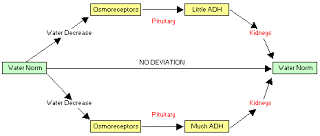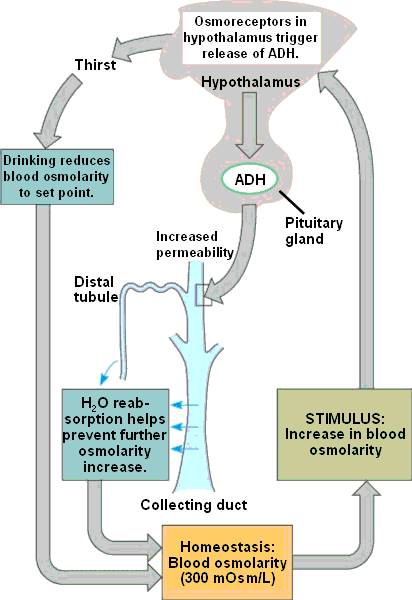Biology
 Osmoregulation is the control of the water content of body fluids. It is part of homeostasis, the maintenance of a constant internal environment.
Osmoregulation is the control of the water content of body fluids. It is part of homeostasis, the maintenance of a constant internal environment.
It is important that cells are surrounded by tissue fluid of a similar water potential to their own contents, to avoid too much water loss or gain which could disrupt metabolism. You have seen that water is lost from the fluid inside a nephron as it flows through the collecting duct. The permeability of the walls of the distal convoluted tubule and collecting duct can be varied.
ADH
ADH is antidiuretic hormone. It is secreted from the anterior pituitary gland into the blood.
When the water potential of the blood is too low (that is, it has too little water in it), this is sensed by osmoreceptor cells in the hypothalamus. The osmoreceptor cells are neurones (nerve cells). They produce ADH, which moves along their axons and into the anterior pituitary gland from where it is secreted into the blood.

The ADH travels in solution in the blood plasma. When it reaches the walls of the collecting duct, it makes them permeable to water. Water is therefore reabsorbed from the fluid in the collecting duct and small volumes of concentrated urine are produced.
When the water potential of the blood is too high (that is, it has too much water in it), this is sensed by the osmoreceptor cells and less ADH is secreted. The collecting duct walls therefore become less permeable to water and less is reabsorbed into the blood. Large volumes of dilute urine are produced.
Negative feedback
The mechanism for controlling the water content of the body, using ADH, is an example of negative feedback.
When the water potential of the blood rises too high or falls too low, this is sensed by receptor cells. They cause an action to be taken by effectors which cause the water potential to be moved back towards the correct value.
In this case, the receptors are the osmoreceptor cells in the hypothalamus, and the effectors are their endings in the anterior pituitary gland that secrete ADH.
- #113 The Control Of Blood Glucose
The blood glucose concentration is regulated by negative feedback control mechanisms. Blood glucose concentration should remain at a fairly constant value of about 100 mg glucose per 100 cm3 of blood. If blood glucose concentration falls well below...
- #111 Production Of Urine In A Nephron - Ultrafiltration And Reabsorption
Ultrafiltration occurs at the barrier between the blood and the filtrate in the renal capsule or Bowman's capsule in the kidneys. Ultrafiltration The Bowman's capsule contains a dense capillary network called the glomerulus. Blood...
- #110 Excretion And Structure Of Kidneys
The kidneys remove wastes from the blood and are the effectors for controlling the water potential of the blood. The removal of waste products generated by metabolic reactions inside body cells is called Excretion. Some of these products are toxic,...
- #109 Thermoregulation - The Control Of Body Temperature
One of the most important examples of homeostasis is the regulation of body temperature. It involves both coordination systems - nervous and endocrine. Not all animals can do this physiologically. Endotherms - Animals (e.g. birds and mammals)...
- #108 Homeostasis In Mammals
In the body of an animal conditions such as water concentration, temperature, and glucose concentration must be kept as constant as possible. Control systems that keep such conditions constant are examples of homeostasis; this is the maintenance of constant...
Biology
#112 Osmoregulation

It is important that cells are surrounded by tissue fluid of a similar water potential to their own contents, to avoid too much water loss or gain which could disrupt metabolism. You have seen that water is lost from the fluid inside a nephron as it flows through the collecting duct. The permeability of the walls of the distal convoluted tubule and collecting duct can be varied.
- If they are permeable, then much water can move out of the tubule and the urine becomes concentrated. The water is taken back into the blood and retained in the body.
- If they are made impermeable, little water can move out of the tubule and the urine remains dilute. A lot of water is removed from the body.
ADH
ADH is antidiuretic hormone. It is secreted from the anterior pituitary gland into the blood.
When the water potential of the blood is too low (that is, it has too little water in it), this is sensed by osmoreceptor cells in the hypothalamus. The osmoreceptor cells are neurones (nerve cells). They produce ADH, which moves along their axons and into the anterior pituitary gland from where it is secreted into the blood.

The ADH travels in solution in the blood plasma. When it reaches the walls of the collecting duct, it makes them permeable to water. Water is therefore reabsorbed from the fluid in the collecting duct and small volumes of concentrated urine are produced.
When the water potential of the blood is too high (that is, it has too much water in it), this is sensed by the osmoreceptor cells and less ADH is secreted. The collecting duct walls therefore become less permeable to water and less is reabsorbed into the blood. Large volumes of dilute urine are produced.
Negative feedback
The mechanism for controlling the water content of the body, using ADH, is an example of negative feedback.
When the water potential of the blood rises too high or falls too low, this is sensed by receptor cells. They cause an action to be taken by effectors which cause the water potential to be moved back towards the correct value.
In this case, the receptors are the osmoreceptor cells in the hypothalamus, and the effectors are their endings in the anterior pituitary gland that secrete ADH.
Homeostasis in mammals requires complex systems to maintain internal conditions near constant. The kidneys remove wastes from the blood and are the effectors for controlling the water potential of the blood. a) discuss the importance of homeostasis in mammals and explain the principles of homeostasis in terms of internal and external stimuli, receptors, central control, co-ordination systems, effectors (muscles and glands) b) define the term negative feedback and explain how it is involved in homeostatic mechanisms c) outline the roles of the nervous system and endocrine system in co-ordinating homeostatic mechanisms, including thermoregulation, osmoregulation and the control of blood glucose concentration d) describe the deamination of amino acids and outline the formation of urea in the urea cycle (biochemical detail of the urea cycle is not required) e) describe the gross structure of the kidney and the detailed structure of the nephron with its associated blood vessels using photomicrographs and electron micrographs f) describe how the processes of ultrafiltration and selective reabsorption are involved with the formation of urine in the nephron g) describe the roles of the hypothalamus, posterior pituitary, ADH and collecting ducts in osmoregulation h) explain how the blood glucose concentration is regulated by negative feedback control mechanisms, with reference to insulin and glucagon i) outline the role of cyclic AMP as a second messenger with reference to the stimulation of liver cells by adrenaline and glucagon j) describe the three main stages of cell signalling in the control of blood glucose by adrenaline as follows: ? hormone-receptor interaction at the cell surface ? formation of cyclic AMP which binds to kinase proteins ? an enzyme cascade involving activation of enzymes by phosphorylation to amplify the signal k) explain the principles of operation of dip sticks containing glucose oxidase and peroxidase enzymes, and biosensors that can be used for quantitative measurements of glucose in blood and urine l) explain how urine analysis is used in diagnosis with reference to glucose, protein and ketones |
- #113 The Control Of Blood Glucose
The blood glucose concentration is regulated by negative feedback control mechanisms. Blood glucose concentration should remain at a fairly constant value of about 100 mg glucose per 100 cm3 of blood. If blood glucose concentration falls well below...
- #111 Production Of Urine In A Nephron - Ultrafiltration And Reabsorption
Ultrafiltration occurs at the barrier between the blood and the filtrate in the renal capsule or Bowman's capsule in the kidneys. Ultrafiltration The Bowman's capsule contains a dense capillary network called the glomerulus. Blood...
- #110 Excretion And Structure Of Kidneys
The kidneys remove wastes from the blood and are the effectors for controlling the water potential of the blood. The removal of waste products generated by metabolic reactions inside body cells is called Excretion. Some of these products are toxic,...
- #109 Thermoregulation - The Control Of Body Temperature
One of the most important examples of homeostasis is the regulation of body temperature. It involves both coordination systems - nervous and endocrine. Not all animals can do this physiologically. Endotherms - Animals (e.g. birds and mammals)...
- #108 Homeostasis In Mammals
In the body of an animal conditions such as water concentration, temperature, and glucose concentration must be kept as constant as possible. Control systems that keep such conditions constant are examples of homeostasis; this is the maintenance of constant...
